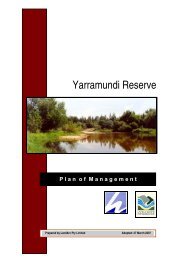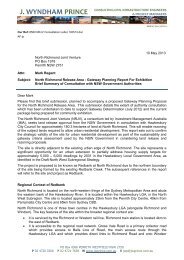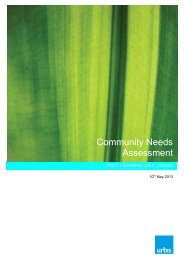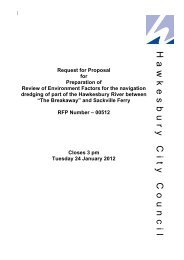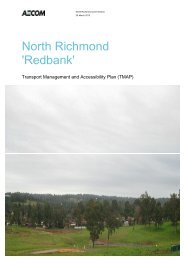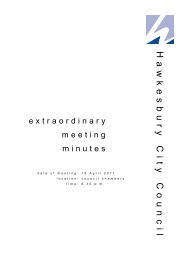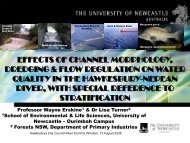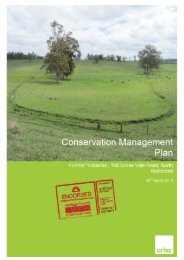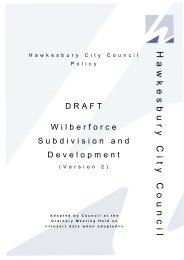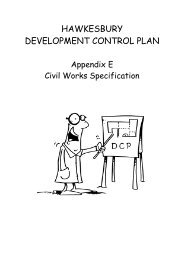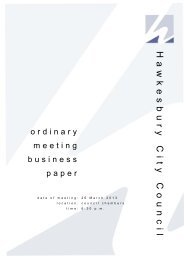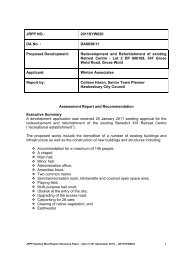Attachment 1 to Item 53 - Roadside Vegetation Management Plan
Attachment 1 to Item 53 - Roadside Vegetation Management Plan
Attachment 1 to Item 53 - Roadside Vegetation Management Plan
You also want an ePaper? Increase the reach of your titles
YUMPU automatically turns print PDFs into web optimized ePapers that Google loves.
H AW K E S B U R Y C IT Y C O U N C IL R O AD S ID E V E G E T AT IO N M AN AG E M E N T P L AN<br />
subdivisions or changes in area zonings will need <strong>to</strong> be balanced with the conservation of road reserve<br />
values.<br />
In addition <strong>to</strong> the above considerations, consideration of State and Commonwealth biodiversity<br />
conservation legislation, such as the TSC Act, EP&A Act and EPBC Act, are required when planning for<br />
the management of roadside vegetation. This is because while the planning component of roadside<br />
vegetation management will not significantly impact matters protected under these Acts, the<br />
undertaking of works may result in significant impacts on protected matters.<br />
3.3 ENDANGERED ECOLOGICAL COMMUNITIES<br />
There are a number of Endangered Ecological Communities (EECs) present within the Hawkesbury<br />
LGA, which are also present within HCC’s roadside reserves. These EECs need <strong>to</strong> be conserved since<br />
they have been heavily cleared in the past and represent the last examples of vegetation communities<br />
of their type. The EECs that have been recorded in the Hawkesbury LGA (NSW NPWS 2002; DECC<br />
2008) include:<br />
• Blue Gum High Forest;<br />
• Castlereagh Swamp Woodland;<br />
• Cooks River Castlereagh Ironbark Forest;<br />
• Cumberland Plain Woodland;<br />
• Freshwater Wetlands;<br />
• River-Flat Eucalypt Forest on Coastal Floodplains;<br />
• Shale/Gravel Transition Forest;<br />
• Shale Sands<strong>to</strong>ne Transition Forest;<br />
• Swamp Oak Floodplain Forest;<br />
• Turpentine-Ironbark Forest; and<br />
• Western Sydney Dry Rainforest.<br />
Conservation of EECs within roadside environments must be balanced against other essential roadside<br />
management requirements (road safety, fire protection, suppression and control, and/or utility<br />
provision). <strong>Management</strong> of roadside environments supporting EECs should also ensure that in addition<br />
<strong>to</strong> the protection of EECs, threats <strong>to</strong> the integrity of the EECs, such as weed invasion and disease, are<br />
considered, with steps taken <strong>to</strong> minimise these risks.<br />
3.4 THREATENED FLORA AND FAUNA<br />
A <strong>to</strong>tal of 34 threatened flora species and 52 threatened or migra<strong>to</strong>ry fauna (1 invertebrate, 7 frogs, 2<br />
reptiles, 2 fish, 35 birds, and 15 mammals, 7 of which are bats), listed under the TSC or EPBC Acts,<br />
have been recorded within the Hawkesbury LGA (DECCW 2009; DEWHA 2009). Some of these may<br />
be present within roadside reserves under HCC’s management, or directly adjacent <strong>to</strong> these areas, and<br />
thus, the management of flora and fauna habitat needs <strong>to</strong> be considered and balanced against other<br />
road management works for road safety or fire protection and prevention.<br />
Threatened flora species and threatened fauna and migra<strong>to</strong>ry species that have been recorded within<br />
the Hawkesbury LGA are listed in Appendix A.<br />
3.5 NATIVE WILDLIFE / FAUNA HABITAT MANAGEMENT<br />
Wildlife habitat, in its broadest definition, includes any vegetation or other physical structure that meets<br />
an animal’s needs for food, shelter, and/or reproduction. Habitat provided by indigenous vegetation<br />
© E C O L O G I C AL AU S T R AL I A P T Y L T D<br />
28



